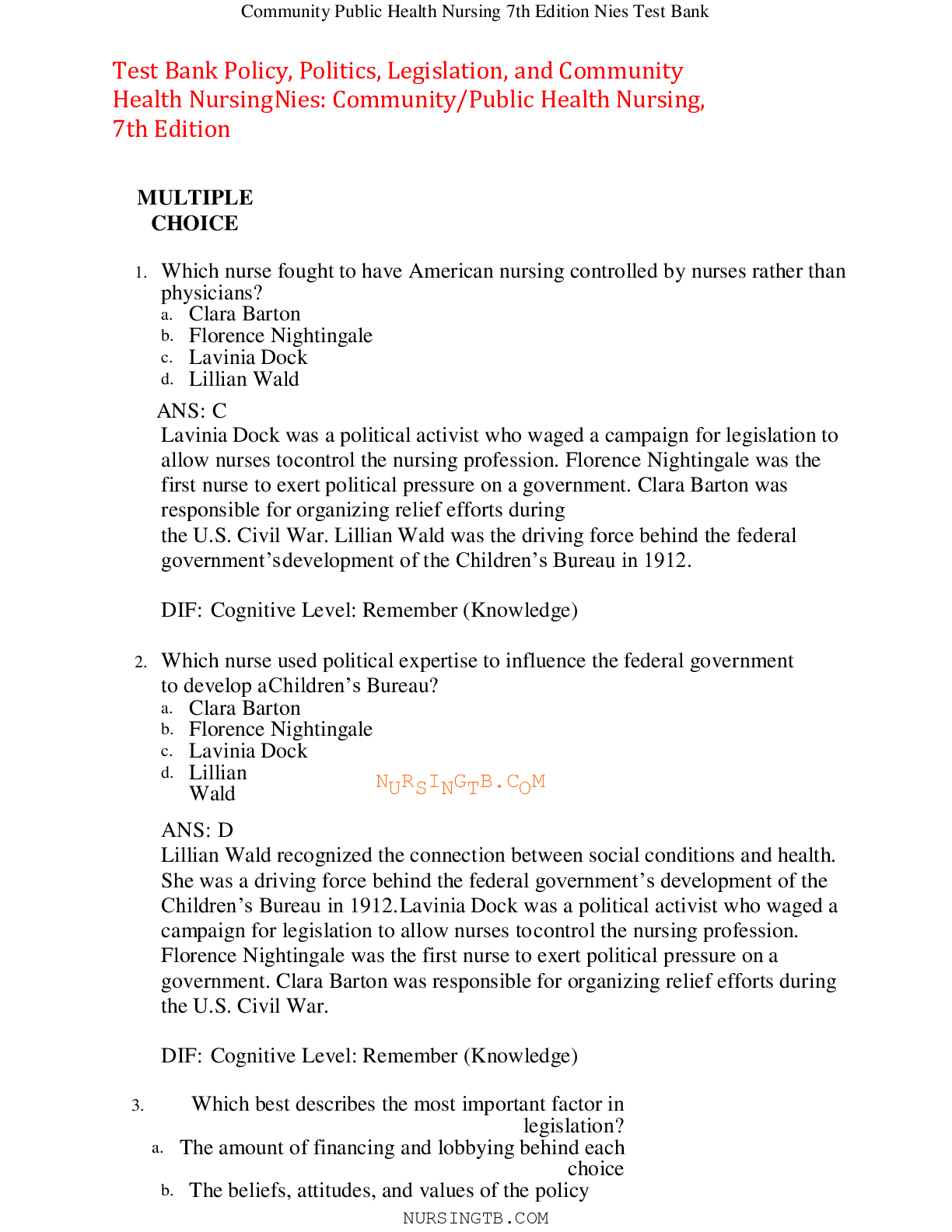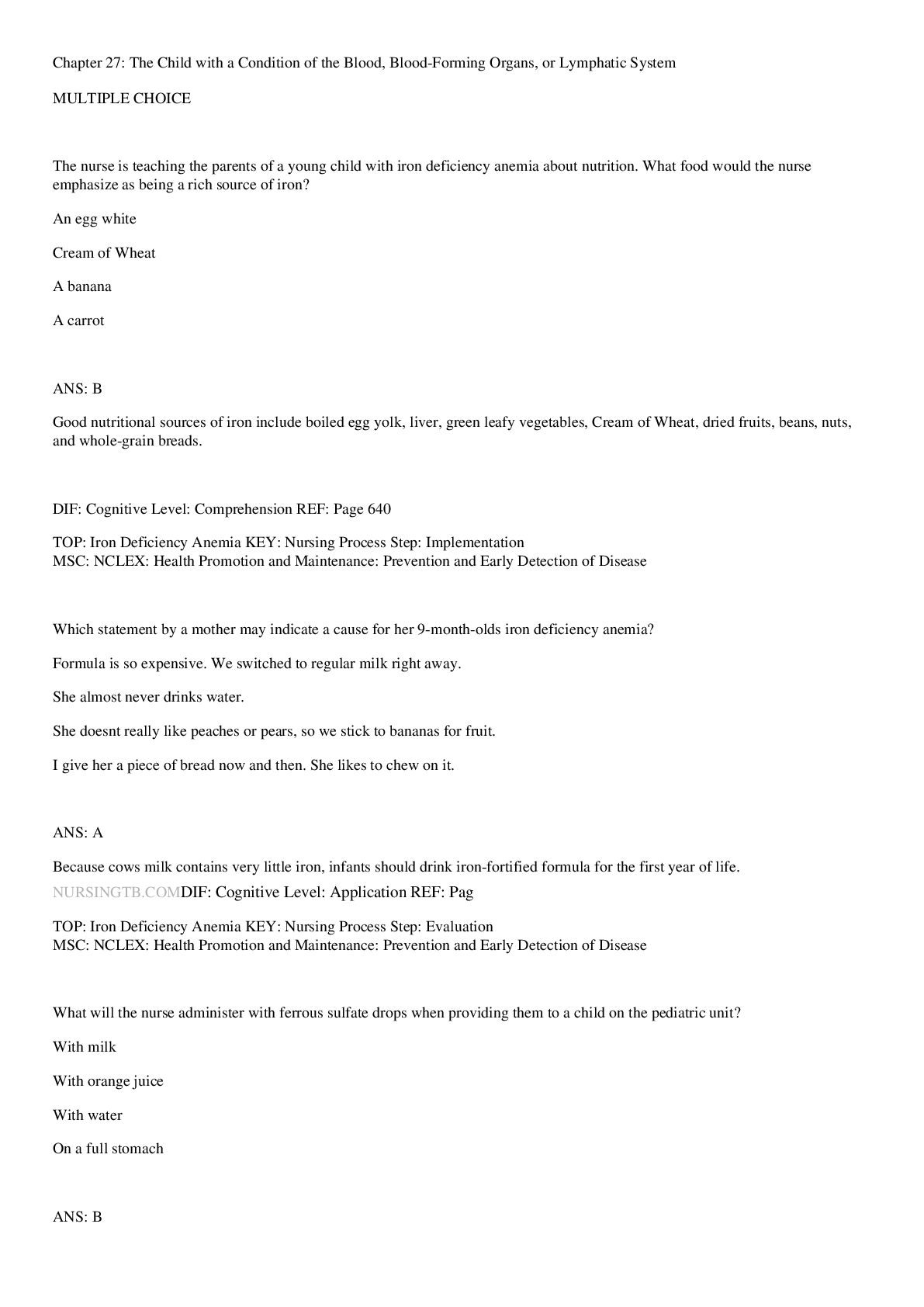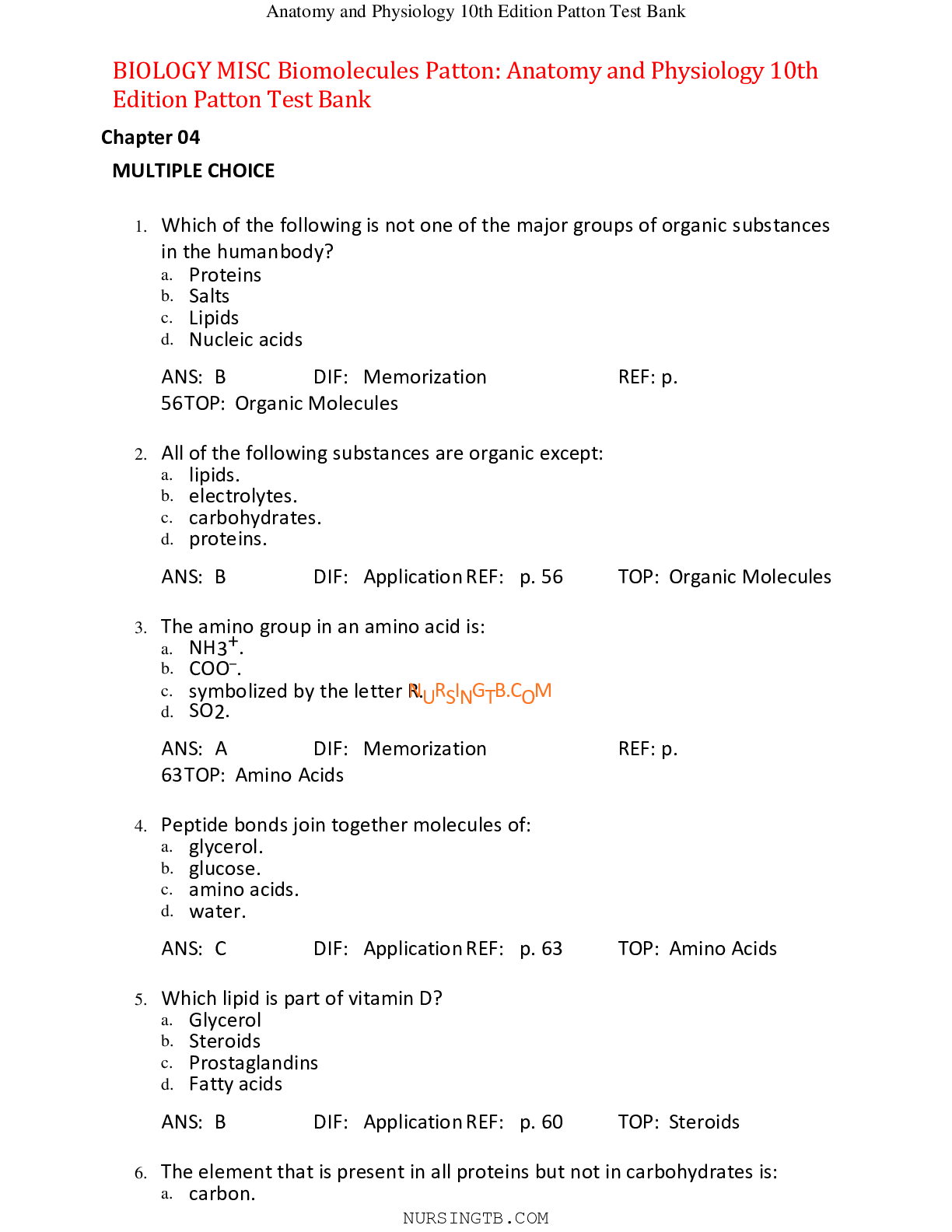*NURSING > TEST BANK > Test Bank: Antimanic Drugs Keltner: Psychiatric Nursing, 8th Edition,100% CORRECT (All)
Test Bank: Antimanic Drugs Keltner: Psychiatric Nursing, 8th Edition,100% CORRECT
Document Content and Description Below
Test Bank: Antimanic Drugs Keltner: Psychiatric Nursing, 8th Edition MULTIPLE CHOICE 1. Maintenance of a therapeutic serum level of lithium is dependent on adequate serum levels of which elect... rolyte? a. Sodium b. Chloride c. Potassium d. Magnesium ANS: A It is believed that lithium substitutes for the sodium (Na) ion in neurons. Reductions or increases in Na intake affect the serum lithium level. The other options have not been identified as critical to lithium level. DIF: Cognitive level: Understanding TOP: Nursing process: Assessment MSC: Client Needs: Physiologic Integrity 2. What phrase represents accurate information about the pharmacokinetics of lithium? a. Wide therapeutic index b. Excreted by the kidneys c. Poorly absorbed in the gastrointestinal (GI) tract d. Provides immediate relief of symptoms ANS: B NURSINGTB.COM Lithium is excreted via the kidneys. The other options are incorrect. The nursing implication is that individuals with renal damage should not be given lithium or should be monitored closely if lithium must be administered. DIF: Cognitive level: Understanding TOP: Nursing process: Assessment MSC: Client Needs: Physiologic Integrity 3. For 2 weeks a patient has taken lithium and risperidone daily for mania. The patient now reports diarrhea, vomiting, and blurred vision. The nurse observes a coarse hand tremor. What is the nurse’s priority action to these assessment finding? a. Administer a PRN dose of benztropine to relieve extrapyramidal symptoms (EPSEs). b. Hold the next dose of risperidone to prevent further drug-drug interaction. c. Reassure the patient that these side effects will decrease with time. d. Notify the prescribing physician immediately. ANS: D The symptoms the patient is experiencing are consistent with a serum lithium level above the therapeutic level. The nurse should withhold the next dose, arrange for a stat serum lithium level determination, and notify the health care provider. Risperidone can be continued because this is not a drug-drug interaction problem. Administration of benztropine is inappropriate because these are not EPSE symptoms. Reassurance would be appropriate, but the patient should not be told that these symptoms will decrease with time and continued dosing. DIF: Cognitive level: Applying TOP: Nursing process: Implementation MSC: Client Needs: Physiologic Integrity 4. A patient has taken lithium 300 mg three times daily for 1 week. The patient reports the presence of fine hand tremors and thirst. What is the nurse’s priority action to these assessment finding? a. Increase sodium in the patient’s diet. b. Immediately obtain a serum lithium level determination. c. Comfort the patient that these effects will probably decrease over time. d. Withhold the lithium until the patient no longer exhibits these side effects. ANS: C These side effects are common and often decrease or disappear over time with continued lithium therapy. Dietary sodium should remain unchanged to keep the lithium level stable. These side effects do not suggest the need for determination of a lithium level. Lithium should not be withheld, because these are not toxic symptoms. DIF: Cognitive level: Applying TOP: Nursing process: Implementation MSC: Client Needs: Physiologic Integrity 5. A patient who has taken lithium for 6 months reports, “I go to the bathroom many times a day and pass large amounts of very pale urine.” The nurse’s action should be based on the understanding that these symptoms may indicate which problem? a. Atactic toxicity b. Uremic syndrome c. Diabetes insipidus d. Interstitial nephritis ANS: C NURSINGTB.COM Symptoms of diabetes insipidus include voiding large amounts of dilute urine many times a day. Nephrogenic diabetes insipidus is caused by the inhibition of the cyclic adenosine monophosphate (cAMP)–dependent action of the antidiuretic hormone on the distal-tubule collecting duct cells. This problem is sometimes associated with lithium therapy. The symptoms detailed are not consistent with any of the other options. DIF: Cognitive level: Analyzing TOP: Nursing process: Evaluation MSC: Client Needs: Physiologic Integrity 6. Which patient should be assessed most carefully for evidence of lithium toxicity when lithium is prescribed with which additional medication? a. Indomethacin b. Risperidone c. Ziprasidone d. Olanzapine ANS: A The combination of lithium and indomethacin is more likely to produce lithium toxicity than lithium and any other drug listed. Nonsteroidal antiinflammatory drugs reduce renal elimination of lithium, thereby increasing serum lithium levels. DIF: Cognitive level: Analyzing TOP: Nursing process: Assessment MSC: Client Needs: Physiologic Integrity 7. A patient with rapid-cycling bipolar disorder is not responding to lithium therapy. At the next multidisciplinary team meeting, the nurse should point out that many rapid-cycling patients have been effectively treated using what medication? a. Sertraline b. Phenytoin c. Benztropine d. Divalproex ANS: D Valproates (like divalproex) are considered first-line agents in the treatment of mania. Valproates are especially effective in the treatment of rapid-cycling bipolar disorders. None of the other drugs mentioned are indicated for treatment of manic states. DIF: Cognitive level: Understanding TOP: Nursing process: Implementation MSC: Client Needs: Physiologic Integrity 8. A patient diagnosed with mania begins lithium therapy on October 1. What is the earliest date a nurse can expect to see clinical improvement in the patient’s condition? a. October 3 b. October 8 c. October 21 d. November 1 ANS: B Lithium must be given for 7 to 10 days before clinical improvement is achieved. N R I G B.C M DIF: Cognitive level: Applying TOP: Nursing process: Evaluation MSC: Client Needs: Physiologic Integrity 9. A patient diagnosed with bipolar disorder asks the nurse, “Why can’t I take my lithium just once a day at bedtime? It’s hard to remember to take it three times.” The nurse’s reply should be based on what information? a. The half-life of lithium is short. b. Renal excretion is greater at night. c. GI absorption is diminished at night. d. The toxicity potential increases with once-a-day dosing. ANS: A Lithium has a short half-life, high toxicity, and rapid renal excretion, so multiple daily doses are required. The other statements are incorrect or are not factors considered in dosing. DIF: Cognitive level: Understanding TOP: Nursing process: Implementation MSC: Client Needs: Physiologic Integrity 10. A patient has taken lithium 600 mg three times daily for 1 week. A laboratory result in which range shows that the desired serum lithium level was achieved? a. 0.2 to 0.6 mEq/L b. 0.6 to 1.2 mEq/L c. 1.2 to 2 mEq/L d. 2 to 2.6 mEq/L ANS: B Therapeutic serum lithium levels are 0.6 to 1.2 mEq/L. The other options are either too low or too high. Serum levels above 1.5 mEq/L can cause symptoms of toxicity. DIF: Cognitive level: Applying TOP: Nursing process: Evaluation MSC: Client Needs: Physiologic Integrity 11. When should the nurse scheduling the serum lithium level blood draw for a patient arrange for it to be obtained? a. Before the first morning dose b. 2 hours after the morning dose c. At bedtime d. Any time during the day ANS: A Lithium levels should be drawn 8 to 12 hours after the last dose, making premedication morning blood draws optimal. DIF: Cognitive level: Applying TOP: Nursing process: Implementation MSC: Client Needs: Physiologic Integrity 12. A patient’s serum lithium level is 1.8 mEq/L. What is the nurse’s priority action related to this evidence? a. Restrict fluid intake. b. Assess for signs of toxicity. c. Encourage intake of high-potassium foods. d. Ensure that the patient is NswaRllowIingGtheBc.apCsulMes. ANS: B U S N T O A serum level of 1.8 mEq/L is higher than desirable. It suggests that the patient might be experiencing toxic effects. Clinical assessment should be conducted. A nurse should not rely entirely on laboratory tests but should make careful clinical assessments. None of the other options would be appropriate. DIF: Cognitive level: Applying TOP: Nursing process: Implementation MSC: Client Needs: Physiologic Integrity 13. Before beginning lithium therapy, the nurse should educate a patient about laboratory tests to assess for adequate function of which system? a. Peripheral vascular b. Reproductive c. Respiratory d. Renal ANS: D Because lithium is excreted via the kidneys, renal system function must be adequate if lithium toxicity is to be prevented. Functioning of the other systems has no direct relationship to lithium therapy. DIF: Cognitive level: Applying TOP: Nursing process: Implementation MSC: Client Needs: Physiologic Integrity 14. Teaching for a patient who is to be discharged on a maintenance dose of lithium should emphasize the importance of management activity? a. Keeping appointments for serum lithium level testing b. Engaging in daily cardiotonic exercise c. Reporting anticholinergic side effects d. Maintaining a tyramine-free diet ANS: A Regular evaluation of serum lithium levels will be part of the patient’s aftercare for as long as he or she takes lithium. The other items are not included in discharge teaching for a patient taking lithium. DIF: Cognitive level: Applying TOP: Nursing process: Implementation MSC: Client Needs: Physiologic Integrity 15. The spouse of a patient diagnosed with bipolar disorder tells the nurse, “Every time my partner recovers from a manic episode, depression follows soon. It’s very discouraging.” The nurse’s reply should include what information? a. As the partner ages, rapid cycling will decrease. b. Combining lithium with haloperidol (Haldol) might prevent rapid cycling. c. Depression associated with bipolar disorder is usually time-limited, so treatment is not indicated. d. Recent addition of olanzapine to this patient’s drug regime can be helpful as a mood stabilizer. ANS: D Olanzapine, an atypical antipNsycRhotiIc, hGas pBro.veCn eMffective in controlling mania and acting as a mood stabilizer to reduce depression following treatment for acute mania. The other statements are incorrect or irrelevant. DIF: Cognitive level: Applying TOP: Nursing process: Implementation MSC: Client Needs: Physiologic Integrity 16. For patients diagnosed with bipolar disorder, valproate anticonvulsants are likely to help control rapid-cycling episodes by what process? a. Inhibition of kindling activity in the brain b. Decreasing availability of norepinephrine c. Increasing dopamine levels at synapses d. Decreasing GABA metabolism ANS: A The effectiveness of valproate anticonvulsants for management of bipolar disorder may be related to inhibition of kindling activity, which stabilizes neuronal activity and increases the threshold of stimulation necessary for cell firing. There is no current research to support any of the other options. DIF: Cognitive level: Understanding TOP: Nursing process: Planning MSC: Client Needs: Physiologic Integrity 17. A patient with a long history of multiple sclerosis developed psychosis with acute mania. The nurse should anticipate that the health care provider will probably prescribe which medication to help stabilize the mania? a. Lithium b. Amitriptyline c. Divalproex d. Diphenhydramine ANS: C The valproates are first-line drugs for treatment of manic episodes associated with bipolar disorder or resulting from general medical problems. They have a rapid onset and are well tolerated. Lithium takes 7 to 10 days to modify symptoms. Diphenhydramine and amitriptyline have sedative side effects but would not stabilize the mania. DIF: Cognitive level: Understanding TOP: Nursing process: Planning MSC: Client Needs: Physiologic Integrity 18. Which patient would require careful assessment for toxic effects of lithium when combined with what additional medication? a. Hydrochlorothiazide b. Lorazepam c. Clozapine d. Oxazepam ANS: A Hydrochlorothiazide is a diuretic used to treat hypertension. The diuretic effect would increase serum concentrations of lithium, potentially producing toxicity. Benzodiazepine and antipsychotic drugs are commNoUnRlySuIseNd GcoTnBcu.rrCenOtlMy with lithium to control mania. DIF: Cognitive level: Analyzing TOP: Nursing process: Assessment MSC: Client Needs: Physiologic Integrity 19. A nurse should schedule a weekly complete blood cell count (CBC) for a patient beginning therapy with which antimanic drug? a. Lithium b. Valproate c. Quetiapine d. Carbamazepine ANS: D Agranulocytosis is known to be an occasional but potentially dangerous adverse effect of carbamazepine therapy, hence the need for regular CBCs. The other drugs have a lower risk of causing this effect. DIF: Cognitive level: Applying TOP: Nursing process: Planning MSC: Client Needs: Physiologic Integrity MULTIPLE RESPONSE 1. A patient diagnosed with mild lithium toxicity with a serum level of 1.6 mEq/L. Which assessment findings are most likely and will require nursing attention? (Select all that apply.) a. Coarse hand tremor b. Elevated white blood cell count c. Dizziness d. Facial tics e. Coordination problems ANS: A, C, E The symptoms of mild toxicity are often related to central nervous system disturbance. Difficulty concentrating might also be noted. Mild GI disturbances are also seen. The other options are not symptoms of early lithium toxicity. DIF: Cognitive level: Applying TOP: Nursing process: Assessment MSC: Client Needs: Physiologic Integrity 2. A patient who is to be discharged on a maintenance dose of lithium should be taught to report which symptoms/signs immediately? (Select all that apply.) a. Large amounts of dilute urine b. Prolonged nasal congestion c. Severe muscle stiffness d. Unusual sweating e. Blurred vision ANS: A, E Patients must be taught the difference between symptoms of minor toxicity and those of major toxicity, such as giddiness, tinnitus, blurred vision, dilute urine, and ataxia. None of the other options are related to lithium toxicity. DIF: Cognitive level: ApplyinNg R I GTOBP:.CNursMing process: Implementation MSC: Client Needs: Physiologic Integrity 3. Which assessment findings validate that a patient with bipolar disorder is experiencing mania? (Select all that apply.) a. Pacing b. Agitation c. Drowsiness d. Delusional thoughts e. Psychomotor retardation ANS: A, B, D Agitation, increased motor activity (pacing), and delusional thoughts may all accompany mania. The patient with mania would have an increased level of alertness rather than drowsiness. Psychomotor retardation would be expected with depression. DIF: Cognitive level: Understanding TOP: Nursing process: Assessment MSC: Client Needs: Psychosocial Integrity 4. A nurse prepares to lead a psychoeducational group for patients who take anticonvulsants to manage bipolar disorder. The nurse should invite patients who take which drugs? (Select all that apply.) a. Lithium b. Aripiprazole c. Lamotrigine d. Gabapentin e. Carbamazepine ANS: C, D, E Lamotrigine, carbamazepine, and gabapentin are anticonvulsants. Lithium is effective in treatment of bipolar disorder, but it is not an anticonvulsant. Aripiprazole is an antipsychotic medication. DIF: Cognitive level: Applying TOP: Nursing process: Planning MSC: Client Needs: Psychosocial Integrity NURSINGTB.COM [Show More]
Last updated: 1 year ago
Preview 1 out of 15 pages
Instant download

Buy this document to get the full access instantly
Instant Download Access after purchase
Add to cartInstant download
Reviews( 0 )
Document information
Connected school, study & course
About the document
Uploaded On
Oct 18, 2021
Number of pages
15
Written in
Additional information
This document has been written for:
Uploaded
Oct 18, 2021
Downloads
0
Views
35




















